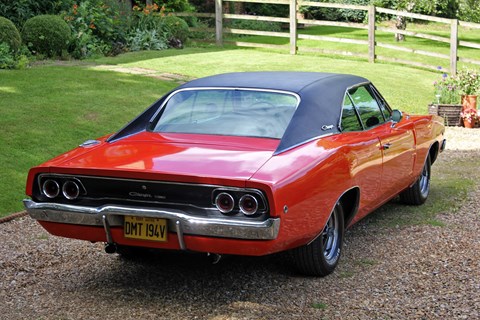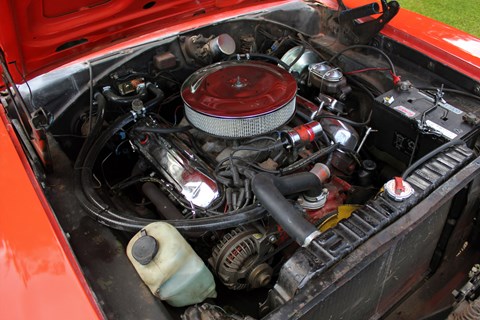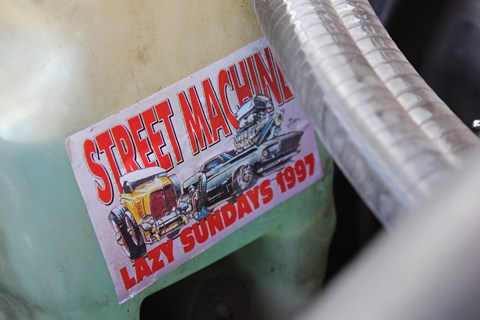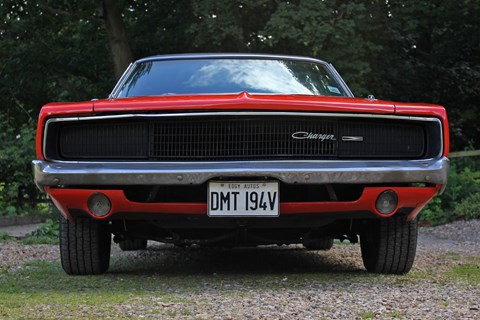► CAR’s 1968 Dodge Charger long-term review
► Parked for a decade and slowly being revived
► Restoration, maintenance and upgrade tales
Update 1 on running a 1968 Dodge Charger: a not-so-casual introduction
It's amazing how much force it takes to stretch a brake shoe retaining spring. If you've never done it before, it's akin to single-handedly trying pull a house down. You hook one end of the spring into a hole on the brake drum shoe, and then stretch it and hook the other end to the brake drum's backing plate.
This stretched spring then provides the tension to keep the brake shoes from coming into contact with the drum. Stand on the brake pedal and the brake cylinders will push the shoes outwards, the friction material will run up against the rotating drum, and the car will slow. Release the pedal and the springs will pull the brake shoes back in, so the car can continue unencumbered.
It requires a lot of tension to do this reliably, and for countless years and miles, so the springs are very strong. Consequently, you've really got to put your back into it if you want to stretch one out to the right length, so you can hook it into its mounting points, but the springs are predictably difficult to get a decent grip on.
That's why, as I watched the fully extended spring slip from the nose of my pliers, I knew I was in trouble. Every ounce of muscle I'd been employing to pull the spring to the right length now suddenly had nothing to hold it back.
My view filled with pliers and clenched fist as, with almighty force, I punched myself in the face. My teeth merrily cut through the soft flesh of my lip and then provided a rattling end stop to the energetic swing, pliers serving as a makeshift knuckledusters.
I instinctively rolled my head back to try and minimise the blow. That would have been fine, except I was sitting in the confines of the wheel well, so I simply drove my head into the underbody of the car. I reflected that this was perhaps not going quite as well as I'd hoped. Michigan steel, I concluded, would continually win out against English flesh and bone.

Time was of the essence, however; I waited for the stars to pass, reset the spring, and my teeth, and gripped the confounded coil of steel with the pliers again. Rinse and repeat five more times and, provided you remain conscious for the process, you'll have reinstalled all the required springs for the rear brake drums on many a classic car.
I was admittedly somewhat out of practice, which wasn’t helping. Fortunately, ‘the knack’ emerges after two or three attempts – greatly reducing your frustration and facial harm. However, I found myself questioning myself – again, with increasing agitation – about what I was actually doing.
You see, I had sternly told myself several times that I was not going to get involved another project. Spin the clocks back a few years and you’d have found me underneath a heavily modified ’68 Firebird. That too, having been thrown loosely back together before being imported into the UK, turned into a long-winded and expensive affair. When it was finally more than a collection of high-end parts flying in loose formation, my love for it was long expended – so I sold it.
Then, despite desperately wanting a standard R32 GT-R, my sanity promptly exited stage left – and I bought a slightly tired Lancia Delta. Yes, it was an HF Integrale. Yes, a lot of what they tell you about those cars is true – including their astonishing ability to create invoices. When the bill arrived, marking the completion of its return to the road, my heart did somersaults of joy. Lo, at the bottom of the page, was a total figure that – unbelievably – was well within the agreed expenditure for the rebuild.

Alas, I then realised that it was page one of four, and the light of enthusiasm for the little Lancia was promptly extinguished in its entirety. Pro tip: if you’re buying a Delta, make sure you’ve enough money to buy two – because at least you can then enjoy it without having to worry about it self-terminating and becoming a garden ornament. Or at least refresh and uprate it a little, so it performs in a fashion that’s more befitting.
The fact that, a day after buying the Integrale, a low-mileage and completely standard R32 had materialized down the road – for the same money – served as yet another kicker. Still, I’d rather regret the cars I’ve bought than the ones I haven’t. So, the Lancia came and went, as did several others, but nothing really lit the fires.
It eventually came to pass that, seemingly, what I really wanted was another muscle car. After all, most were reliable, tough, easy to work on and remarkably responsive to upgrades. More importantly, to me at the time, I felt that I would simply enjoy just cruising around in one. There would be no need to push it to its limits in order to find the experience gratifying, as smoothly tackling a straightforward series of curves at a sensible speed would likely prove to be an entertaining challenge. Plus, any muscle car of the right era would fit neatly into several local car shows and events, meaning I could do far more with it than simply tinker and travel.

So, I saved up, avoided the previous ‘project’ pitfalls and bought a presentable, well-sorted classic that I could begin enjoying immediately. Or I would have, at least, if my inner masochist hadn’t played havoc with my purchasing decisions. As fate would have it, just down the road from where I lived, I spotted a car for sale. It was a 1968 Dodge Charger, and a full-fat 440 at that. It hadn’t turned a wheel for a decade but I managed to convince myself that, being relatively simple, it was hopefully in need of less recommissioning than Chernobyl’s No.4 reactor.
I also figured it was the last opportunity for me to buy one, before they became completely unattainable. A terrifyingly simple online form granted me access to a loan of several thousands, and – after some back-of-napkin calculations – I made the finances work. The deal was struck and, for £15,000, I landed myself nigh-on two tonnes of dilapidated American icon.
‘Doesn’t look like it needs much,’ asserted the delivery driver as he deposited the creaking, dust-laden Charger onto the drive. Some eighteen months and exactly £10,706 later, resulting in what you see before you now, I’m pretty confident that I’ve proven him wrong. It’s the small victories you have to celebrate, in some cases.
Logbook: 1968 Dodge Charger 440
Engine 7210cc 16v naturally aspirated V8, some power @ a few thousand rpm, a lot of torque off idle
Transmission Three-speed automatic, rear-wheel drive
Stats Pleasantly quick, several kg/km CO2
Price £15,000
Costs this month £0
Costs to date £10,706
Total to date £25,706
Miles this month 83
Total 182.6
Our mpg 11.2
Official mpg TBC
Fuel costs £39.14
Read more long-term tests here
